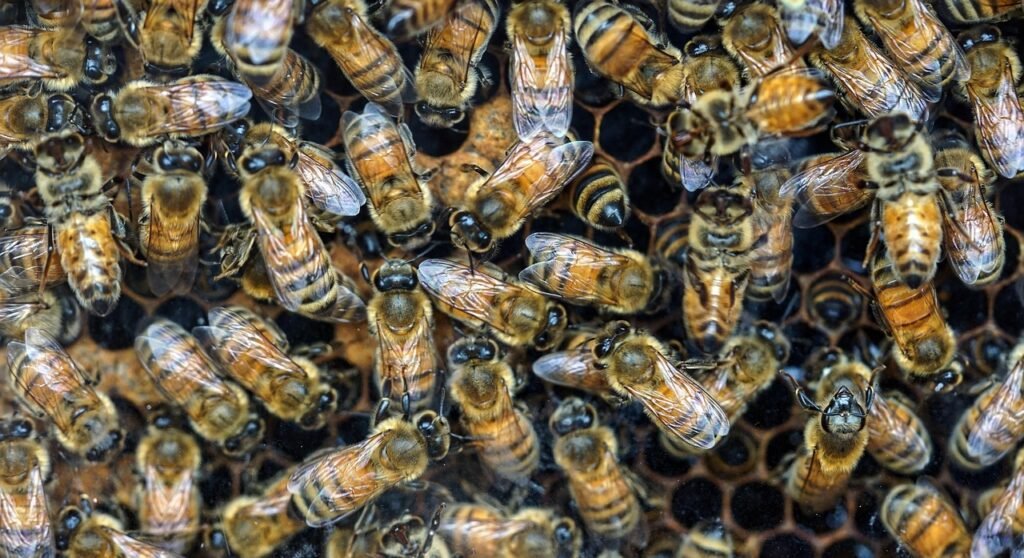Bee lifespan is the typical time an individual bee lives as an adult, which varies by species and caste. In honey bees (Apis mellifera), workers live ~5–6 weeks in summer or 4–6 months in winter, drones about 1–2 months, and queens commonly 1–4 years depending on conditions.
Why “Bee Lifespan” matters and what we mean
When people ask “How long do bees live?”, they often mean honey bees. But “bee” is a huge group: social honey bees and bumblebees, and thousands of solitary species (like mason or leafcutter bees). Even within honey bees, lifespan depends on caste and season. Workers (non-reproductive females) forage and wear out fast in summer, yet the colony produces long-lived “winter bees” with different physiology that carry the hive through cold months.
It also matters because colony health and crop pollination depend on having enough long-lived adults at the right times. Queens that fail early, workers shortened by parasites or pesticides, or drones ejected before they mate can all reduce colony strength. U.S. researchers track these issues on the USDA ARS honey bee health page, which summarizes disease, nutrition, and management findings for beekeepers.
Honey bee (Apis mellifera) lifespans by caste
Honey bee lifespans differ dramatically by role.
Workers. In the busy nectar flow of spring–summer, a worker typically lives around five to six weeks because foraging is physically costly. In contrast, “winter bees” live roughly four to six months due to their altered physiology and indoor work.
Queens. Queens can live longer than any other caste. Modern operations often replace queens after 1–2 years for productivity, but scientific reviews report potential averages of 3–4 years, with rare cases longer. Both the range and beekeeper practice explain why answers differ.
Drones. Male drones mainly exist to mate. Those that succeed die immediately after mating; those that do not are often expelled as nectar wanes in autumn, leading to short lives—on the order of weeks to a couple of months.
At-a-glance: typical adult lifespans
Below is a practical summary for the common western honey bee (Apis mellifera). Values vary with climate, forage, parasites, and management.
| Caste (Apis mellifera) | Typical Adult Lifespan | Notes |
|---|---|---|
| Worker (summer) | ~5–6 weeks | High foraging wear; short-lived in active season. |
| Worker (winter) | ~4–6 months | “Winter bees” with different physiology live much longer. |
| Queen | ~1–4 years (productive life often ≤2 years) | Potential averages 3–4 years, but many are replaced earlier in practice. |
| Drone | ~1–2 months; die after mating; expelled in fall | Autumn eviction conserves stores; mating is fatal. |
Life cycle timing: egg → larva → pupa → adult
How fast a bee becomes an adult (and what she eats) helps determine her eventual lifespan and role. Queens develop the fastest, workers at a standard pace, and drones the slowest. A widely used Cooperative Extension table shows classic timings: queens emerge in ~16 days, workers ~21 days, and drones ~24 days.
These timings also shape colony rhythm. A queen that fails or is lost can be replaced rapidly because a new queen can be raised and emerge within about two weeks from egg to adult, while workers and drones take longer. The size/orientation of cells and a rich diet of royal jelly drive queen-worker differences—more than DNA alone.
| Caste | Egg (days) | Larva (to capping) | Pupa (capped) | Total to Emergence | Source |
|---|---|---|---|---|---|
| Queen | ~3 | to day ~8–9 (capping ~day 9) | ~7 | ~16 days | UGA Extension. |
| Worker | ~3 | to day ~9 (capping ~day 9) | ~12 | ~21 days | UGA Extension. |
| Drone | ~3 | to day ~10 (capping ~day 10) | ~14½ | ~24 days | UGA Extension. |
What shortens or extends a bee’s life?
Season and workload. Summer foragers burn out quickly; winter bees persist. Colonies also adjust foraging distances as landscapes change—typical foraging ranges are around 0.8–2.0 miles (1.3–3.2 kilometers), with longer flights when resources are scarce, increasing wear.
Nutrition. Pollen quality, diversity, and access influence longevity and gland development. Reviews and experiments show protein-rich, diverse pollen can extend worker lifespan and improve resilience; poor diets do the opposite.
Parasites and viruses (Varroa & DWV). The mite Varroa destructor and deformed wing virus (DWV) reduce worker lifespan and drive winter losses across regions, making mite management central to colony survival.
Pesticides. Studies (e.g., Oregon State University) have demonstrated shortened worker lifespans after exposure to certain widely used pesticides, underscoring the value of integrated pest management and exposure reduction.
Genetics and role. Queens and winter workers invest energy differently than summer foragers, which helps explain their longer lives. Colonies under stress (queen failure, high mite loads, poor forage) skew age structure in ways that can reduce average lifespan.
Beyond honey bees: bumblebees and solitary bees
Bumblebees (genus Bombus). Most of the nest—old queen, workers, and males—dies at season’s end. Newly mated queens enter a long winter “sleep” (diapause) for ~6–9 months, then found new colonies in spring. Adult worker bumblebees typically live a few weeks.
Solitary bees (e.g., mason/leafcutter). These species spend most of the year as developing juveniles in nests. The adult stage that we notice is brief—usually ~3–8 weeks—just long enough to mate and provision nests. Regional guidance for mason bees notes adult activity of roughly 4–8 weeks in spring.
This diversity means “bee lifespan” depends on which bee you mean. It also shows why habitat and seasonal forage matter for landscapes as much as for apiaries.
FAQ
Do honey bees really fly miles to forage, and does that affect lifespan?
Yes. Typical foraging ranges are around 0.8–2.0 miles (1.3–3.2 km), but bees can go farther when local resources are poor. Longer flights cost more energy and can shorten forager careers.
Why do some sources say queens live 1–2 years while others say 3–4?
Beekeeping practice (replacing queens early for productivity) often yields 1–2 years, but research and managed colonies can observe 3–4-year averages or more; both statements can be true in different contexts.
What happens to drones in autumn?
As nectar declines, workers evict drones from hives to conserve honey. Drones that mated earlier have already died; the rest perish outside the colony.
What Did We Learn Today?
- Worker honey bees live ~5–6 weeks in summer but ~4–6 months in winter—season and role matter.
- Queens can live 1–4 years depending on conditions and management, with early replacement common.
- Drones live weeks to a couple of months, die after mating, and are evicted in autumn.
- Development is fast: 16 days (queen), 21 (worker), 24 (drone)—timing that shapes colony recovery.
- Nutrition, parasites (Varroa & DWV), and pesticides can shorten lifespans—good forage and management help.





